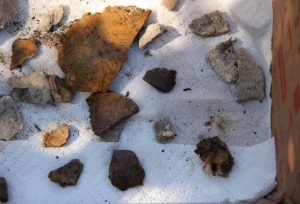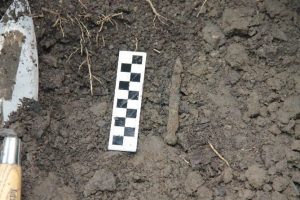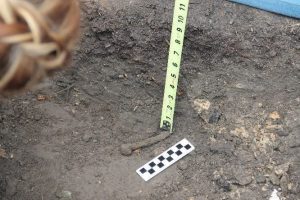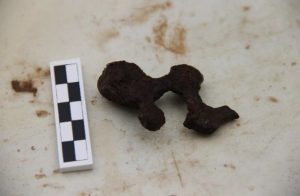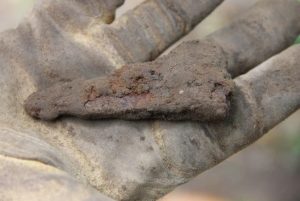Here Lie the Remains
During the last week of August 2015, human skull fragments were found behind the House of the Seasons, specifically in the soil around an ornamental shrub which had just been installed by Roy Koopman’s work crew (J D’s Plant Farm and Landscaping, Marshall, Texas). Over the next several days, examination of the soil in the root ball area of the planting unearthed many more skull fragments.
The Collins Academy consulted several experts, beginning with George Avery, PhD, Director of the Anthropology and the Archaeology Laboratory at Stephen F. Austin State University, to determine the next steps in the discovery process. He said that accidental finds of Caddoan remains in East Texas, including skulls in private yards and on public grounds, are fairly common and that he is presented annually with several to examine in the Nacogdoches area. Avery recommended a ground penetrating radar survey of the finds’ location at the House of the Seasons and indicated Zac Selden, PhD, a research associate at SFA, might be able to conduct it. He also stated that the Caddo Nation of Oklahoma does not allow DNA analysis of remains. He did, however, advise that a coroner or forensic pathologist should examine the bones. Avery further helped by informing the Caddo Nation of Oklahoma of the finds and that they were likely Caddo Indian remains.
Avery also apprised the Texas Historical Commission’s Archaeology Division of the situation. A Commission representative sent a packet of relevant information for anyone discovering an unmarked cemetery. The packet consisted of (1) an Archaeologist’s Notice of Existence of Cemetery, (2) a Historic Texas Cemetery Designation description, (3) the Historic Texas Cemetery Request for Designation forms, and (4) the Guidelines for Preserving Historic Cemeteries in Texas.
A forensic pathologist from Marshall, Dr. Robert Palmer, inspected all the bone fragments and concluded that they were human and old. The Jefferson Police Department, called to the site early on, had thought the skull fragments were from an animal like a dog or cat. Jefferson PD received an audio tape of Dr. Palmer’s comments made as he examined all the bone fragments found to that point in time.
In addition, Richard Collins met with Sunday Eiselt, PhD, Associate Professor of Anthropology at Southern Methodist University in Dallas, to ask about the appropriate steps to determine the ethnicity of the remains. Eiselt reiterated the Caddo ban on DNA analysis. She thought the bones were probably Caddoan but advised against DNA analysis due to the Caddo prohibition.
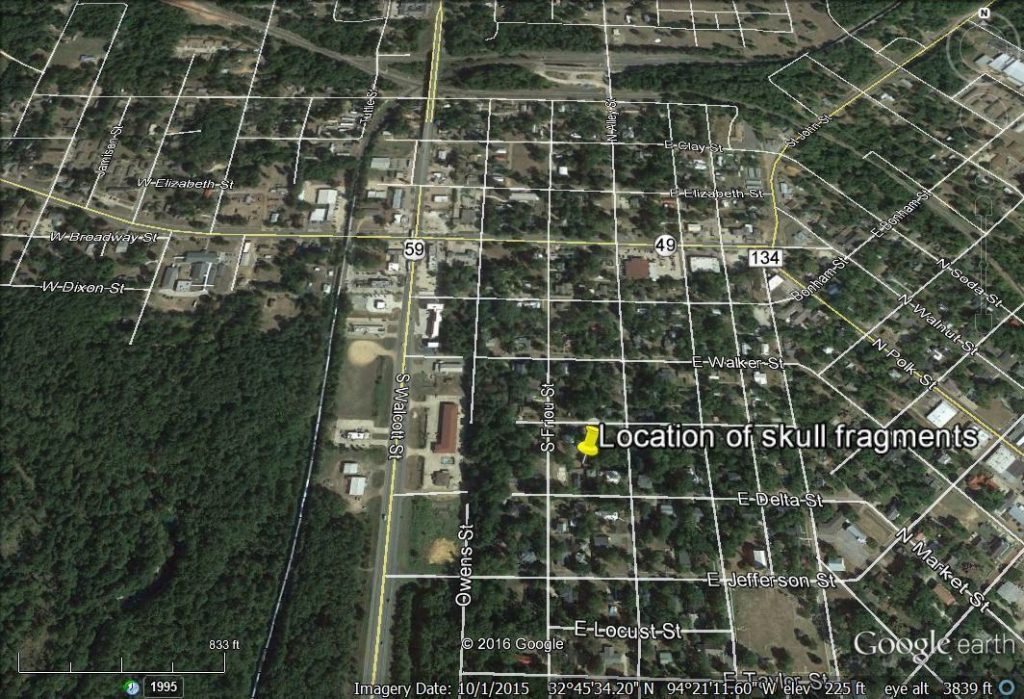
The location of bone fragments in the backyard of the House of the Seasons in the historic residential area of Jefferson, Texas, is pictured above.
Who Are You?
Background Information
Dr. Palmer made three defining observations. The first was that the bone fragments were from a human skull. The second finding was that the bones were old, not ancient or modern. The remaining feature Palmer noted was that the cause of death could not be determined because the skull was broken into so many pieces. Palmer’s observations suggest three possible sources for the origin of the skull fragments:
- a Native American
- an early Anglo settler
- an enslaved African
Native Americans occupied the region for at least 10,000 years, with many Caddo Indians living in northeast Texas up until the early 1840s when they were forced to move to reservations. It is important to note that mound building in the Caddoan culture ceased around 1000 AD. And after European contact in 1542, old-world diseases decimated Native American populations in northeast Texas. Three hundred years later, the first Anglo settlers arrived in the area to find deserted villages as evidence of a once large and thriving civilization (Tiller 2010). The general area within which Jefferson was later established was a wilderness until Anglos began to settle it in the 1830s. After the Louisiana Purchase in 1803, American emigrants remained on the eastern side of the Red River until the Caddo Indians were removed. They then spilled over into Caddo Prairie and, along with steamboat navigation, slowly progressed upstream and westward until reaching the future site of Jefferson.
In 1838, Allen Urquhart received 1,280 acres of land as a headright divided into two
640-acre sections. One became the city of Daingerfield; the other became the business district of Jefferson. The other half of early Jefferson came from a purchase by Daniel Alley of the Stephen Smith headright in 1845, encompassing the land immediately west of Urquhart’s, to develop a residential area (Bagur 2012). It is in this residential area where the House of the Seasons stands today and the bones were accidentally found.
Lots in Jefferson began to sell by 1844. Dr. Isaac Tabor, Jeptha Crawford, John Withee, Bennett Martin, Edwin Rogers, and Mansell Matthews were early lot holders in Jefferson and had a great interest in opening navigation for economic purposes. Construction on the first structures began in October 1844, about the time that William Perry had completed the bayou clearing effort to open up channels for river transportation to Jefferson.
On March 5, 1845, the 68-ton riverboat Lama arrived in Jefferson to pick up cotton that was ready for market. Being labor intensive, the presence of the crop is indicative of enslaved African manpower on the farms and plantations across the landscape around Jefferson. By June 1845, the town was emerging into reality with structures including a grocery and warehouse, a hotel, and several log cabins.
By 1860, 266 enslaved Africans were living in Jefferson (there was no Slave Schedule with the 1850 Census). They belonged to 65 owners and were housed in 73 cabins. The largest owner group in town was the mercantile class, which consisted of 23 members owning 123 slaves. The second largest group was attorneys, who owned 32 slaves. The primary position in town for female slaves was as domestics in private residences. The primary positions for male slaves in town were as freight and stock movers. As time and workloads permitted, owners hired out their slaves to others for profit (Bagur 2012).
Careful examination of the Abstract of Title for the House of the Seasons property (No. 2000 by C & H Abstract Company of Jefferson for Richard H. Collins) revealed the sequence of Block O and Block P property owners prior to the involvement of future House of the Seasons owner Ben Epperson. When this information is correlated with the data presented in the Slave Schedule of the 1860 Census for Jefferson, a minimum total of 25 slaves residing in Blocks O and P between 1854 and 1860 is determined. From the Abstract of Title, William Perry is indicated as the first buyer after Daniel N. Alley was able to purchase the Stephen Smith headright. Perry’s purchase in 1849 was for Lot 7 of Block P. By this time, Perry and his wife, Sardinia, had already given a portion of Block 86 to his slaves and employees, including free men of color, for a place of worship. This church parcel was deeded in 1851, the year William Urquhart was finally granted Patent to the land. In December 1867, William and Sardinia Perry again deeded the same parcel to use as a Negro Baptist Church (Russell 1973).
Evidence
Stephen F. Austin State University set up a ground penetrating radar (GPR) survey on January 22, 2016, during which Zac Selden located soil anomalies considered helpful in finding additional artifacts.
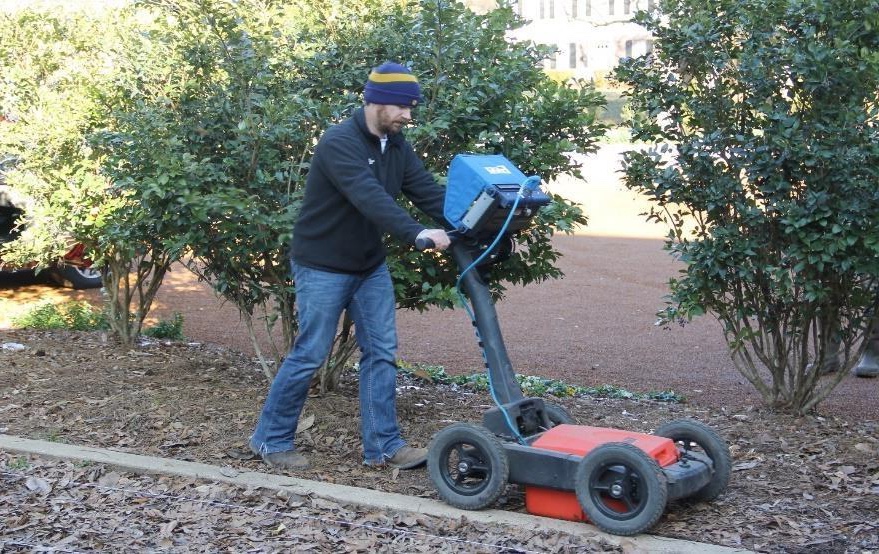
Zac Selden conducts a ground penetrating radar survey in immediate area of the finds behind the House of the Seasons.
A survey team conducted a systematic archaeological excavation of four one-meter units on May 23, 2016, where indicated by Selden’s analysis of his previous GPR survey. This location was very close to and due east of the accidental finds location, and the excavation yielded the artifacts listed below.
Artifacts Found during May 23, 2016, Excavation
Early machine-cut, square-head nails………………….30
Human bone fragments……………………………………..11
Crockery shard…………………………………………………..2
Metal hinge……………………………………………………….1
Decorative hardware………………………………………….1
Glass and ceramic debitage………………………………..100
Findings were sparse and could possibly represent components of a coffin (nails, hinge, and decorative hardware) consistent with what might be expected from a Christian burial. However, both vertical and horizontal soil horizons of all excavation units showed extreme disturbance and repeated mixing of the soil over time. The many glass and ceramic shards were found in the upper layers and come from nineteenth- and twentieth-century trash piles. Mixed with the trash layers were chunks of lumber, some with nails and some without. This location once held a store room and then a small greenhouse that was used for storage. Used lumber was apparently stored for longer periods of time, and some of it was forgotten and left to rot. There was also a wash house in close proximity. The lack of a marker, cemetery designation, or relics from other known Anglo burial traditions greatly reduces the chance of a European origin of the bones.
Heavily rusted nails unearthed during May 23, 2016, excavation
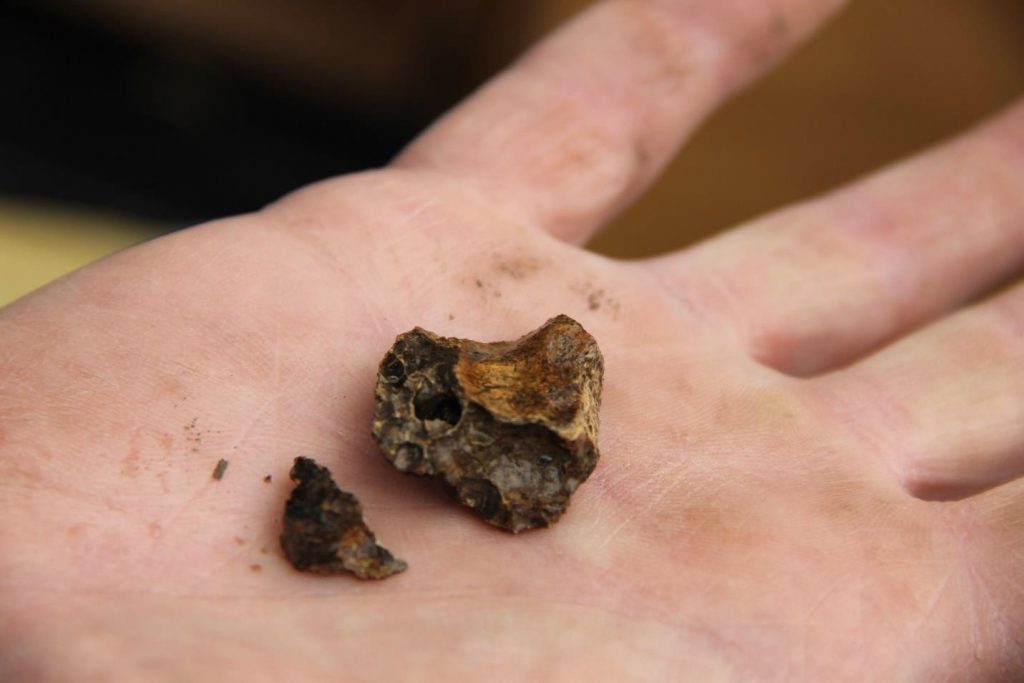
Bone fragments from the May 23 excavation
Hardware from the May 23 excavation
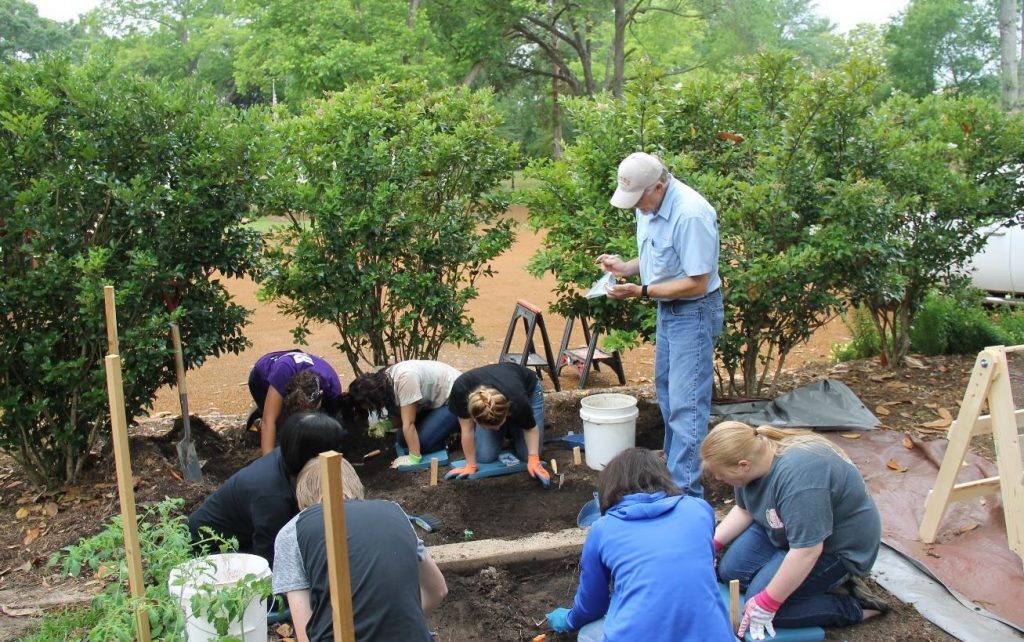
The survey team works on four one-meter units on May 23, 2016.
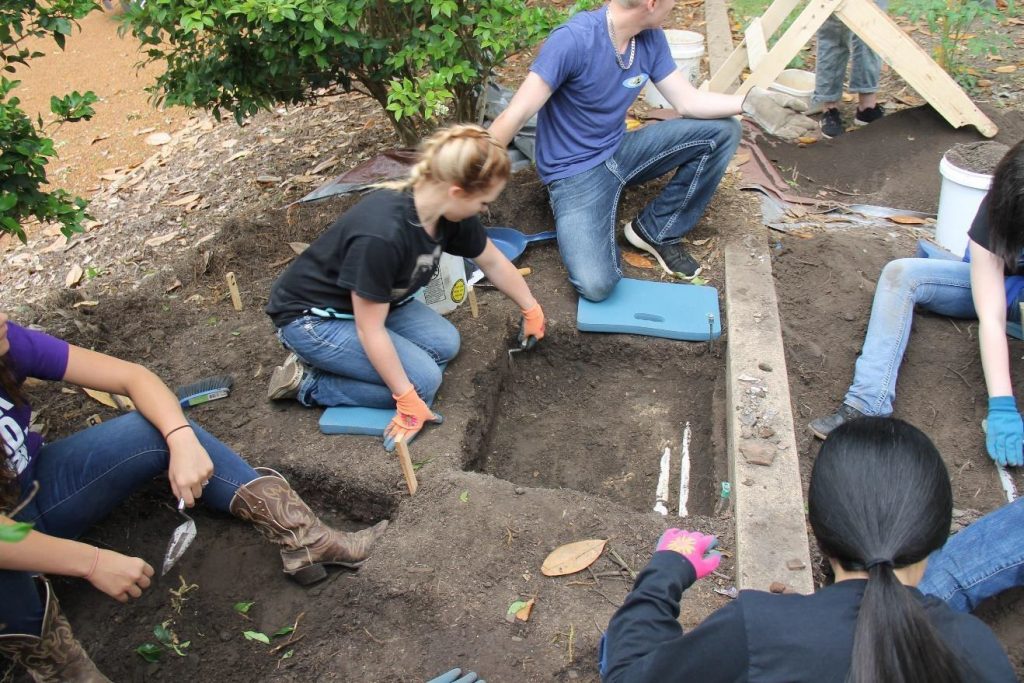
Next to a modern retaining wall, the excavation team uncovers sections of PVC tubing used by the current landowner’s irrigation system.
The 1872 Brosius map below depicts numerous outbuildings (slave/contract labor cabins) behind four residences on the northern half of Block P between Delta and Baker streets (two facing Alley Street and two facing Friou Street).
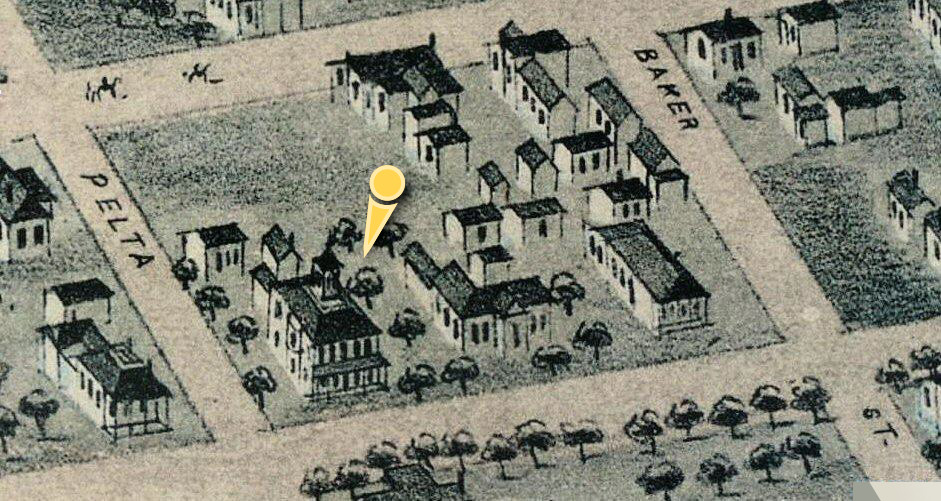 This 1872 Brosius map shows Block P and approximate location of the finds.
This 1872 Brosius map shows Block P and approximate location of the finds.
Inferences Drawn
The statement from Dr. Palmer that the skull fragments were old—not ancient and not modern—is significant. The apparent age and deteriorated condition of the remains suggests the bones were in place long before Anglo settlers arrived in the 1830s. If the site was an intentional burial, interment could have taken place as long ago as 1,000 years, the point in time when the Caddo ceased building mounds. If the individual was alone at death and simply fell to the ground, then this also most likely would have occurred long before the arrival of Anglos and the slaves they brought.
An illuminating finding was the omnipresent disturbance of the associated soil by the property’s chain of landowners. Land use and management shifted and overturned soil, damaging skeletal remains repeatedly over the past 172 years. Modifications started with shallow disturbances such as shovel-dug latrines, hand-hoed gardens, and surface trash piles. The use of burn pits and plows would cut deeper and spread remains farther. In more modern times, a wash house stood over the area, and later a greenhouse was used for storage there. More recent installation of a retaining wall, a sprinkler system, and a row of hedges further dismembered and scattered remains. Of peculiar note is the fact that the human bones, although present for hundreds of years, were not recognized as such until the hedge planting incident of August 2015.
Honor At Last!
Through deductive reasoning, the ethnicity of the bone fragments discovered behind the House of the Seasons must be Native American; specifically, a Caddo Indian. More definitive articulation is not possible without an extensive excavation of a much larger area and DNA analysis of the finds. Because the Caddo Nation of Oklahoma prohibits destructive analysis of skeletal remains, no such testing was, or will be, conducted.
Skull fragments and other bones collected and stored over the period of this investigation have been placed in a wooden box decorated with Caddo Indian signs and reburied at the location where they were found. In accordance with Caddo beliefs, it is hoped that the reburial has honored the disturbed spirit and set it free. A small monument marks the location and reads, “Here lie the remains of a Caddo Indian known only to God.” The marker shall stand for posterity to honor and memorialize this particular soul and all Native Americans whose lives and times were so greatly altered by Anglo America’s manifest destiny to spread across and possess the whole of the continent.
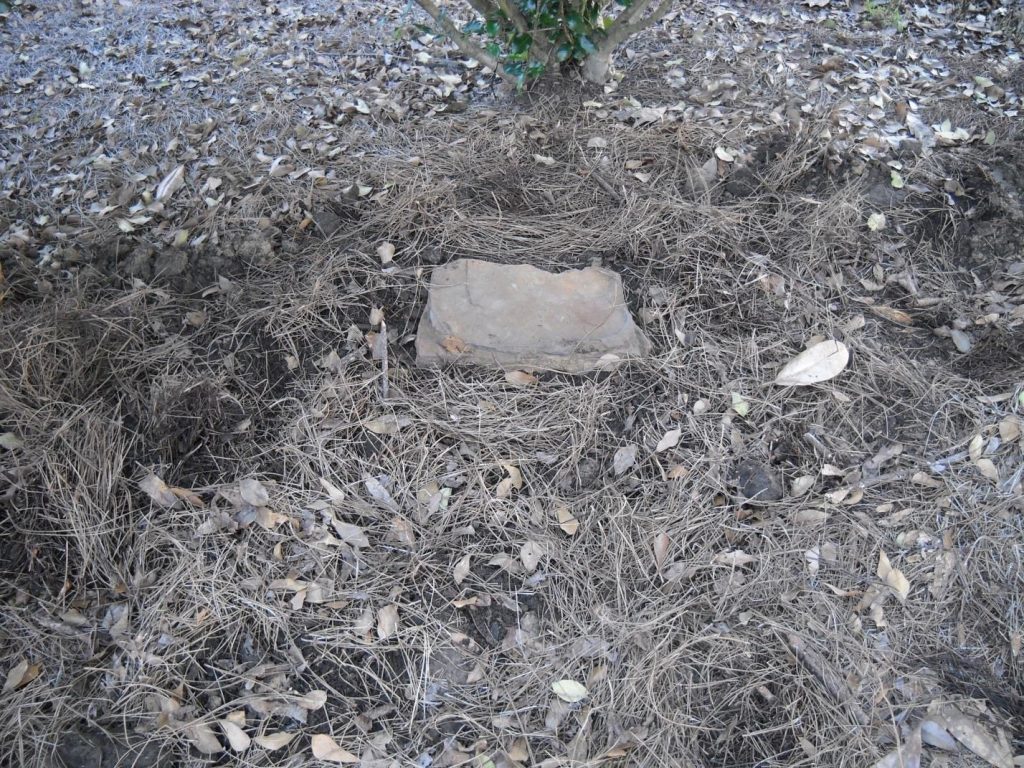
Here lie the remains of a Caddo Indian known only to God
References
Abstract of Title for the House of the Seasons property (No. 2000 by C & H Abstract Company of Jefferson for Richard H. Collins).
Bagur, Jacques D. 2012. Antebellum Jefferson, Texas: Everyday Life in an East Texas Town.
Brosius, Herman. 1872. Map of Jefferson, Texas.
Russell, Traylor. 1973. Carpetbaggers, Scalawags, and Others. Waco: Texian Press.
Tiller, Jim. 2010. Before the Line, Vol. I, An Annotated Atlas of International Boundaries and Republic of Texas Administrative Units Along the Caddo Lake-Sabine River Borderland, 1803-1841. Nancy T. Tiller.

